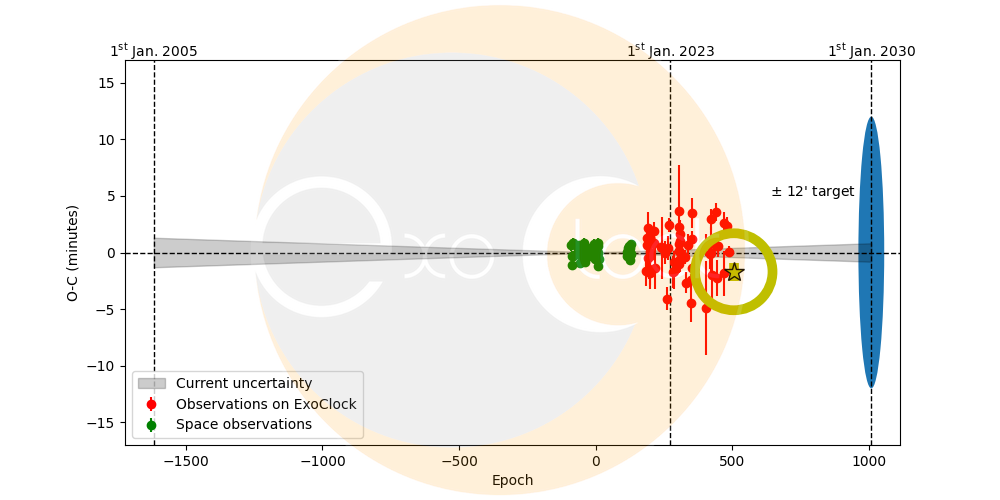Contribution by Dr. Gerold Holtkamp, June 2025
The measurements were taken from 12:14 a.m. UTC on March 18, 2025, to 4:32 a.m. UTC on March 18, 2025, in Osnabrück, Sonnenhügel. The Moon was 87% illuminated and 103° distant. It set around 6:05 a.m. UTC. Sunrise was already around 5:30 a.m. UTC, which is why measurements could only be taken until about half an hour after the end of the transit.
The measurement technique used:
Telescope: Skywatcher Newton 250/1200 mm
Mount: Skywatcher AZ-EQ6
Filter: Luminanz (Antlia)
Camera: QHY268M with gain 60, offset 20, chip temperature -10° C
Guiding: Skywatcher Guidescope Evoguide 50 ED with camera ZWO ASI120mm
NINA was used for camera and mount control.

The present measurement and the subsequent evaluation with the hops software of the Exoclock-Project resulted in:
Rp/Rs = 0.1481 +/- 0.0021 (expected 0.14762 +/- 0.00035) *
--> Rp = 0.1481 x 495,098 = 73,324 +/- 1,040 km. [1]
The exoplanet TOI-1259Ab is therefore slightly larger than Jupiter (radius = 69,911 km). Nevertheless, the transit light curve shows a dip of more than 30 mmag, which is due to the small size of the parent star (radius (TOI-1259A) = 0.711 x radius (Sun)). The system is 385 light-years from Earth. The special feature of this system is that the detected planet orbits component A in a binary star system.

The value of the transit's temporal center, which is important for the Exoclock project and is expressed as the difference between the observed and the expected value, is O-C = -1.7 +/- 0.78 minutes**, slightly below the expected value.
The transit light curve measurement of the exoplanet TOI-1259Ab has been published on the Exoclock project website. [2] Two further transit light curve measurements by the author have already been made, dated September 25, 2023, and December 14, 2022. [3]
_____________________________________________________________________________
* [Rp = Rplanet, Rs = Rstar]
If the star's radius is known, the planet's radius is determined directly from the dip in the light curve. (see also https://kosmos-os.de/messung-der-transitlichtkurven-der-exoplaneten-wasp-84b-und-kps-1b-am-7-und-8-maerz-2024)
** [O = Observed, C = Calculated]
[1]
Data on the star system and the exoplanet at
https://exoplanetarchive.ipac.caltech.edu/overview/toi-1259
The radius of the parent star was taken as 0.711 +0.020/-0.019 (Martin et al. 2021) x the radius of the Sun. The radius of the Sun was assumed to be 696,340 km.
[2]
https://www.exoclock.space/database/observations/TOI-1259Ab_2647_2025-03-18_Gerold_1561_Lum
[3]
https://kosmos-os.de/transitkurve-des-exoplaneten-toi-1259-a-b-am-25-26-9-2023
https://kosmos-os.de/soeben-entdeckt-exoplanet-toi-1259-a-b